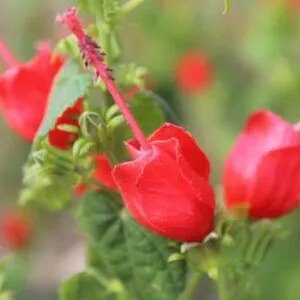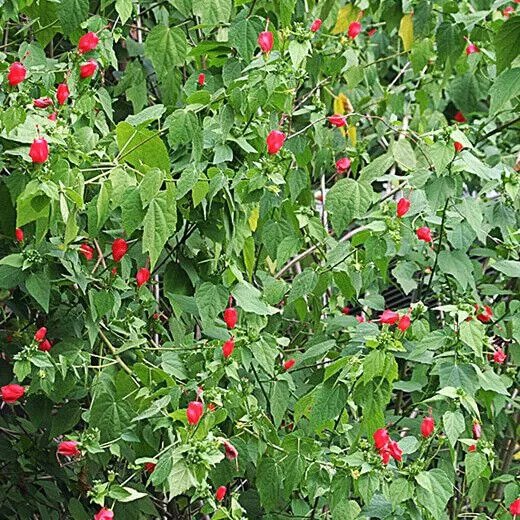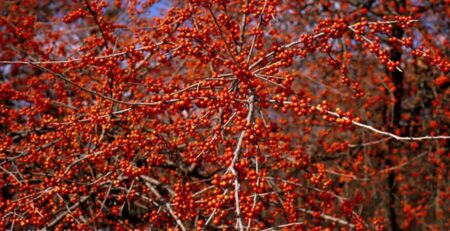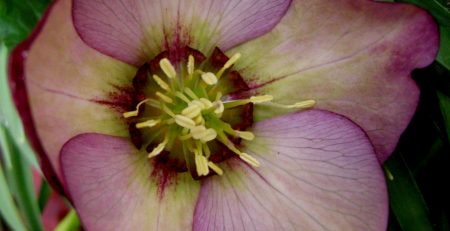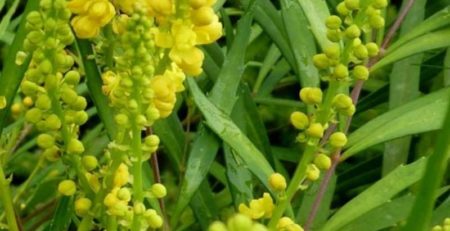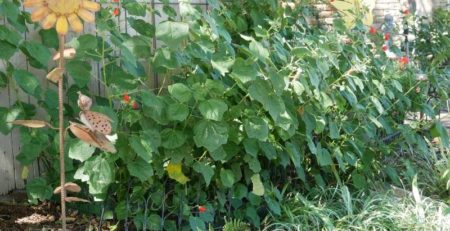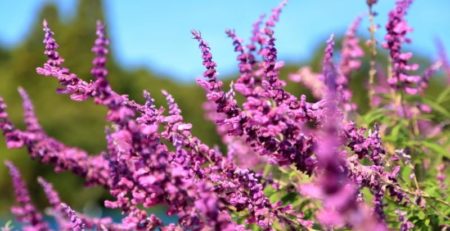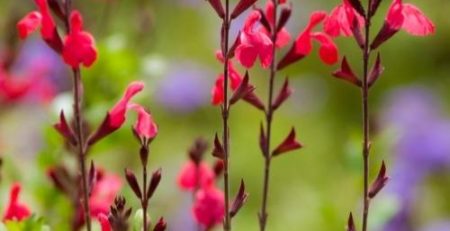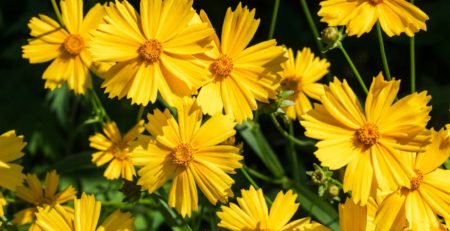Plant of the Month: Big Momma Turk’s Cap
Plant Description:
Shaped like a Turkish turban or fez, the cardinal-red blooms of Turk’s Cap resemble those of a sleepy hibiscus flower with petals that never completely unfurl. For generations, this spectacular shrub has been prized in Southern gardens for its abundant display of uniquely whorled blossoms with showy stamens. Recently, however, a sensational new introduction arrived on the scene. ‘Big Momma,’ an appropriately named hybrid variety with flowers at least twice as large as the native plant, was developed and introduced in 2005 by Texan Greg Grant of Stephen F. Austin University. ‘
Big Momma’ combines the excellent winter hardiness of M. drummondii with the much larger blooms of M. penduliflorus. The result is a versatile, carefree, flowering perennial that exhibits the best qualities of both parents. ‘Big Momma’ is hardy within USDA zones 7-10. In the northern part of its range, it dies back and freezes to the ground in winter but returns with vigorous new growth in spring. In mild winters, it remains green and can grow quite large unless pruned for shaping. This improved Turk’s Cap variety grows 5-6 feet tall and just as wide. It is an adaptable plant with the ability to thrive in wet, dry, alkaline, or acid soil, either in full sun or full shade! However, the more sunlight this plant receives, the fuller the foliage will become and the more flowers it will produce.
‘Big Momma’ is extremely easy to grow and, once established, is tolerant of heat, drought, and salt. Where it is not winter hardy, it can be treated as an annual and makes a brilliant addition to landscape borders, large patio containers, or woodland settings. It complements and looks wonderful among ornamental companions, such as Lyreleaf Sage, Wood Fern, Bamboo Muhly, Hibiscus, or Inland Sea Oats. ‘Big Momma’ displays lush, velvety, oval-shaped green leaves up to 8 inches in length. They are alternately arranged and slightly lobed with serrated margins and pointed tips.
The vermillion-red flowers of ‘Big Momma’ are produced in dazzling profusion on the upper leaf branches of fuzzy stems. They bloom heavily from summer through fall, providing essential nourishment to ruby-throated hummingbirds as they migrate south for the winter. These charming flowers, which attract a wide variety of moths, butterflies, bumblebees, and other beneficial pollinators, gradually give way to marble-sized, edible red fruit. The fruit, which tastes like an apple to some and to others like a watermelon, is often brewed into herbal teas or cooked into jellies and syrups. The fruit is appetizing, not only to humans, but to visiting songbirds; especially mockingbirds, who also devour the seeds. In Mexico, the plant’s leaves and flowers are used in homeopathic medicine to moisturize the skin and ease the digestive system.
Turk’s Cap is a member of the Malvaceae family, which includes all hibiscus, mallows, okra, cotton and hollyhock. Native to the southern United States, it grows naturally in shady, well-drained areas along stream banks and limestone canyon walls. Completely winter hardy in Texas, the native Turk’s Cap was named a ‘Texas Superstar Plant’ in 2011. This is a registered trademark owned by Texas A&M AgriLife Research, a state agency that is part of Texas A&M University. The ‘Texas Superstar’ title is designated for chosen plants of outstanding beauty and performance throughout Texas landscapes. The botanical name of this plant is ‘Malvaviscus drummondii x ‘Big Momma.’ The genetic name, ‘Malvaviscus,’ is derived from a Greek term meaning “sticky mallow,” in reference to sap produced by the plant’s leaves. The species name, ‘drummondii,’ honors the 19th century Scottish-born botanist and plant taxonomist, Thomas Drummond, who traveled throughout the Southwestern United States to collect 750 specimens of native plants. ‘Big Momma’ is a hugely incredible modern improvement of an already remarkable native plant!
Propagation & Planting:
‘Big Momma’ Turk’s Cap performs best in well-drained, moderately fertile soil in sun to part shade. It appears most attractive with a minimum of 4-6 hours of full sun daily. Although drought tolerant once established and not picky about soil type, it thrives in moist soil with a pH ranging anywhere between 6.1 and 7.8. Container-grown shrubs can be found at garden centers specializing in native plants or ordered online.
The best time of year to plant a shrub is in autumn to ensure the root system has time to become established before spring arrives. It is important to gently loosen the root ball before placing the plant into a hole dug twice as wide and just as deep as its purchased container. This plant should be spaced at least 18 inches apart to allow plenty of room for it to grow. ‘Big Momma’ can be propagated from a semi-soft stem cutting. The cutting should be removed from the plant just below a node, pressed into potting medium, and kept moist. This plant is a hybrid and cannot be reproduced from seed.
Propagation:
Stem Cutting
Plant Care:
‘Big Momma’ Turk’s Cap flourishes when well-watered, and it must be irrigated regularly until fully established. After that, the soil should be allowed to dry between each watering. Although this plant will tolerate some drought, a regular watering schedule will encourage more blooms and a more attractive, bushier shape. However, ‘Big Momma’ must never be over-watered, and excellent soil drainage is essential. It should be provided with some shelter from drying or damaging winds. If grown in shade, this plant tends to become leggy and may require to be staking.
Fertilize:
A mid-summer application of a balanced 10-10-10 slow-release fertilizer may help promote fuller growth and more attractive blooms. It is important to carefully read the directions on the product label before using fertilizer.
Prune:
It is important to prune away dead stems in late winter where they have frozen near the ground. This should be done before new spring growth emerges. If the plant becomes leggy, it can be pruned back by a third. ‘Big Momma’ may need occasional trimming to maintain its attractive shape.
Pest & Disease:
‘Big Momma’ Turks Cap is relatively pest and disease-free. Fungal diseases are preventable by monitoring the application of water and making sure the soil is allowed to dry between each watering. During periods of drought or stress, spider mites may attack, resulting in a slight webbing and mottling of the leaves. These insects can be deterred with a spray of insecticidal soap or neem oil, making sure to follow the directions on the product label.
To learn more about ‘Big Momma’ Turk’s Cap, click here: https://planttagg.com/big-momma-turks-cap-planttagg/
PlantTAGG® is the most technically advanced mobile solution for helping gardeners learn about and care for their plants. PlantTAGG’s goal to educate gardeners blends seamlessly with the mission of the Master Gardener program to provide research-based horticultural information to the residents of Dallas County and beyond. To set up your own yard, text ‘PLANTS’ to 46376.
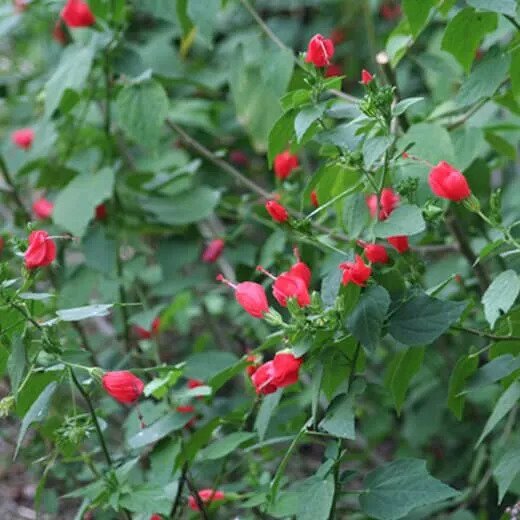
Common Name: Big Momma Turk’s Cap
Botanical Name: Malvaviscus drummondii ‘Big Momma’
Category: Shrub
Lifecycle: Perennial, Annual
USDA Zone: 7B – 10B
Sun Requirement: Full Sun (6+ hours per day), High Shade (1-2 hours per day)
Water Requirement: Low
Soil: Adaptable
pH: Adaptable
Height: 5 to 6 ft
Spread: 5 to 6 ft
Spacing: 2 to 4 ft
Growth Rate: Rapid
Bloom Time: Summer & Fall
Bloom Color(s): White, Red, Pink
Leaf Type: Simple
Leaf Shape: Ovate
Leaf Arrangement: Alternate
Leaf Retention: Deciduous
Fruit: Showy
Miscellaneous: Tolerates poor soil, Native Plant
